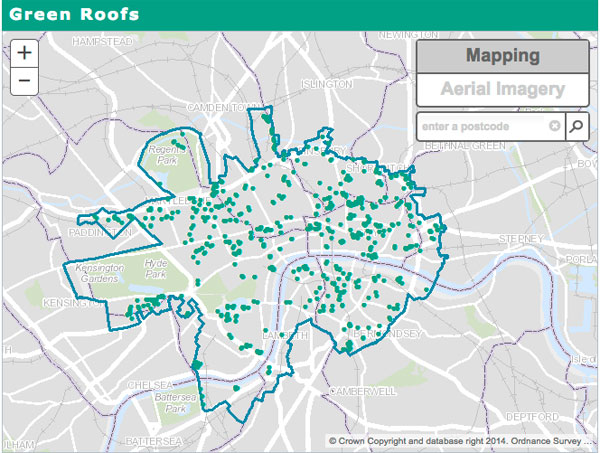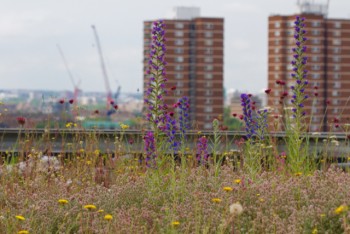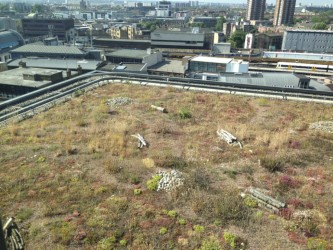Retrofitted green roofs are really going to happen in London. Why? A new Green Infrastructure programme, Twenty 4 Twenty, has been announced. As we at livingroofs.org have been aware for a long time, the water utility would sooner or later have to find some way to fund green roofs in the capital.
In October 2015, Thames Water announced their Twenty 4 Twenty programme, a £20M campaign to transform 20 hectares of grey concrete into green spaces by 2020. This came the day after the Greater London Authority (GLA) also launched their consultation on the London Sustainable Drainage Action Plan – two good pieces of news in a week.
Green roofs in London over the last ten years

At livingroofs.org, we can celebrate what has been achieved over the last ten years. London is a green roof capital, even thoguh much of the national and international press seem unaware of it. Ever since the London Plan policy that we worked with the GLA to produce in 2008, green roofs have blossomed across the city.
Last year, the GLA published the Green Roof Map for Central London, which shows over £175,000m2 of green roofs installed. The majority of these green roofs are on new developments.
The issue for any city – especially a city like London – is how to get green roofs retrofitted onto existing buildings. With over 10M m2 of roof space that could be greened tomorrow in Central London, the potential is huge. Now, with Thames Water’s Twenty 4 Twenty programme, some of these 10M m2 could actually be greened.
Of course, not all the monies will go to green roofs. There will be funds for other Green Infrastructure interventions, such as pocket parks with SUDS schemes, rain gardens, and even vertical rain gardens – green walls that store rainwater.
At livingroofs.org, we support all Green Infrastructure interventions in cities, to deliver multifunctional benefits. Too narrow a focus, solely to store stormwater, could undo much of what has been achieved in the capital. All too often across the globe, we have seen this happen. Drainage is easy for engineers to deal with – SUDS numbers add up, but a single-solution roof that just stores storm water can be relatively dull and underproductive in other ways. There can be blindness to other important city needs such as improving air quality, urban cooling and increasing biodiversity.
Retrofitting green roofs – ensuring quality in the Twenty 4 Twenty programme

Our original focus back in the early 2000s was to ensure that London’s extensive green roofs delivered for biodiversity in a real and meaningful way. We have largely succeeded, as biodiversity is now a real consideration in the specification and implementation of green roofs.
As funding becomes available from Thames Water, we need to ensure that, whilst the quantity of green roofs may increase especially on existing stock, the quality of provision is not compromised.
Retrofitting green roofs is not new. Over the last ten years, some seminal buildings have embraced the idea. Most have been privately funded. These projects show how good quality green roofs can be installed on existing buildings.
Over the last six years, a number of Green Infrastructure Audits in Central London have identified where to install good green roofs on existing building stock. So we have the maps, we have the knowledge – all that’s left now is to deliver. However, once a mainstream market establishes for retrofitting, there is always the risk that a ‘lowest common denominator’ tick box approach dominates. New players seeing money to be made often arrive on the scene with little knowledge and experience.
This is not to say that the current market should be static. There is always room for innovation. But the focus of any innovation should be to ensure that new products, especially any lightweight solutions, do not just deliver for stormwater but also for other needs. We believe focusing on plants, especially on the most beneficial plants to be planted in any new approach – should always be a priority. Delivering for biodiversity needs to be firmly on Thames Water’s radar when distributing their financial investment.
A healthy green roof industry in London

Livingroofs.org has helped establish a healthy green roof industry that delivers green roofs to the capital and across the country.
The UK green roof industry now has a Code of Practice and understands the need for quality – which can be compromised by ‘value engineering’. We need to ensure that, as funds become available, the industry and its real experts are engaged to advise and deliver quality green roofs with multifunctional benefits to the city.
Thames Water’s announcement is to be welcomed. Its Twenty 4 Twenty programme will certainly increase the green roof area of London over the next five years. London will continue to be one of the world’s green roof capitals, providing climate resilience and storm water management, while also increasing biodiversity, air quality, cooling, health and wellbeing.
Bring it on!